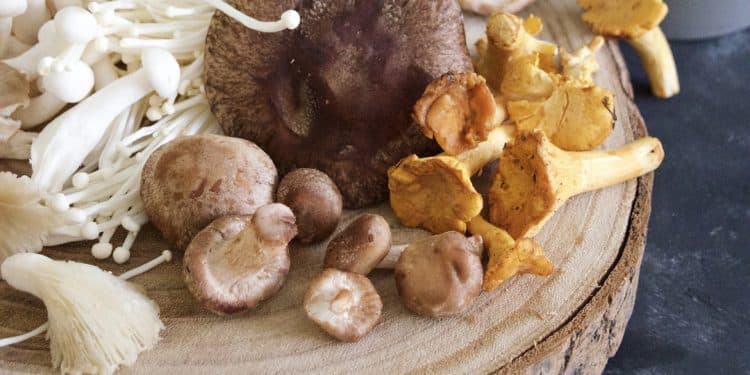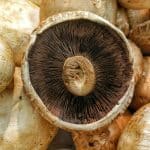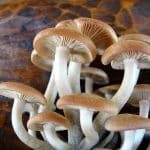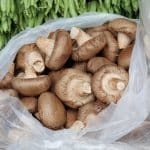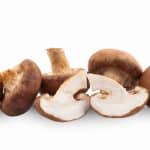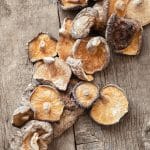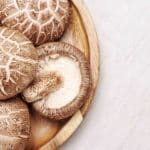As you get deeper into researching for the best functional mushroom supplements, you might find yourself feeling in a little over your head. After all, mushrooms are a diverse, smart organism, serving as the building blocks of nearly all ecosystems on Earth. If this sounds like too much responsibility for one tiny mushroom, it is likely because you are not familiar with mushroom mycelium, the massive, eco-system-wide web of cell-signaling threads that stretch beneath your feet, linking up to 90% of Earths plants into some kind of plant-food-chain that allows interconnectivity and communication. There is much to unpack about functional mushrooms, which extend well beyond the pretty stem-and-cap mushrooms that you are likely familiar with.
We are going to breakdown the differences between fungus mycelium and fruiting bodies, as well as how supplements made with each of these parts work, to help you ultimately decide what is best for you. The fruiting body is the caps and stems portion of the mushroom. The mycelium is the “root” of the mushroom, which makes up more than 90% of the mushrooms mass. Both parts of a mushroom can provide some nutrition and health benefits, but supplements made with mycelia are generally of lower quality. Regardless of the form you opt for, you should always be sure to select high-quality, safe mushrooms supplements.
What Is Mushroom Fruiting Body?
The mushroom fruiting bodies are the parts of a mushroom most people consider to be the “mushroom”, the stalk and cap, and gills, skirts, and other parts attached to the stalk and cap. The fruiting body is the part of the mushroom that you find at the supermarket. Aside from being an iconic location marker for what most people consider to be mushrooms, the fruiting body serves a crucial function to a mushroom: It is the fruit. In other words, the stalk, cap, gills, and other parts of a mushroom growing above ground are all responsible for performing the reproductive tasks.
Specifically, the fruiting body is responsible for the emission of fungus spores, which travel in the air until reaching suitable soil, where they germinate into a single thread of single-cell tissue known as the “hypha”. Together, hyphae grow across the substrate to create an interconnected system called the mycelium.
What is Mushroom Mycelium?
Mycelium is that part of a mushroom which grows below the surface, deeper in the mushrooms substrate. Generally, mycelium is not visible above ground, as is the fruiting body, and most people do not associate this different mushroom system, “roots,” with common mushrooms. Despite that, all mushrooms have diverse under-the-surface mycelium performing critical functions.
Just like plant roots, mycelium is the “feeding” part of the mushroom. It consumes plant material, especially starch or grains, in the vegetative part of a mushrooms life cycle. The mycelium continues to spread out in a Dendritic mode, meaning that it looks like a branching tree, seeking nutrients and water.
Eventually, they will reach another compatible mycelium and merge, sharing the nuclei. A mycelium with two sets of nuclei is able to reproduce sexually, and then, given suitable environmental conditions, it will grow a fruiting body, which releases spores.
This might make a mycelium look much like a plants roots, but keep in mind, mushrooms are not plants. In fact, these organisms are incredibly varied and evolved. Mushroom mycelium is known to have more than 30,000 different species, it can spread beneath the surface of the Earth for miles (the largest known mushroom mycelium covers almost 3.5 square miles), and it even forms symbiotic relationships with plants.
This network of connections, known as the “mycorrhizal network,” helps plants move water, nitrogen, and other important nutrients under the soil. Mushroom mycelium also has a kind of immune system. It is capable of secreting enzymes onto a substrate in order to keep pathogens and competing organisms from damaging the fruits body. In a sense, mushroom mycelium functions in the same manner as a persons nervous system. Either way, since mycelium makes up over 90% of a mushrooms overall mass, it cannot be overlooked.
Mycelium vs Fruiting Body | What are the Differences?
As you can see, a mushroom has much more going for it than just its cap, gills, and stem. The question is, does a fungus actually produce a better additive? , and what is the application of the mycelium of mushrooms for using mushrooms as supplements as well as foods.
At its heart, you can think about it this way, The fruiting body is the reproductive part of a mushroom, while the mycelium is a functional structure that gives life to the fruiting body. The fruiting body is typically the part that is cooked and consumed, but as supplementation of mushrooms becomes more prevalent, mycelium is used more frequently.
Differences in How it’s Grown and Harvested
The fruiting bodies and mycelium are two parts of the same total, however, the growing process of supplements made with the mycelium as opposed to fruiting bodies is very different. To begin, mycelium is added to the material for the “grain starter,” which can be wood, sawdust, oats, wheat, rye, or rice. The mycelium can be allowed to grow for several weeks before being harvested and crushed, typically with most of the grain material still attached, to make mycelium supplements. As you might guess, these are easier to make, but are typically a much degraded product, with just some of the mushroom material and lots of starch.
When a fruiting body is grown, mycelium is added to the grain material and allowed to culture. This substrate is then formed into blocks and exposed to appropriate environmental conditions (moisture, heat, and oxygen) in order to induce the growth of the fruiting bodies.
These fruiting bodies take longer to grow, but are already isolated when harvested. This means supplements made from the fruiting bodies are already concentrated in nature.
Differences in Nutrition and Therapeutic Compounds
Despite mycelium supplements being sometimes called no more than bag of oats, there is still debate over whether or not the mycelium contains any unique and significant nutrients and healing compounds. On the one hand, mycelium is the “life-giving” part of a mushroom, which is responsible for its immune functions. The mycelium literally gives and supports life to the fruiting organism, protecting it against pathogens through its immune system. For this reason, mycelium supplement advocates argue that the mycelium has greater ability to regulate immune function than the fruiting body itself. Research has confirmed that both the mycelium and the substrate in which it grows (which becomes biologically active in the growing process) may induce immune functions.
However, that study looked at the mycelium only and the fermented rice substrate in which it was grown, and did not compare mycelium activity with fruiting-body activity. Of course, advocates for supplements made from fruiting bodies alone are making another argument, the fruiting bodies have a higher amount of beta-glucans than mycelium.
Beta-glucans are the biologically active polysaccharides to which most attribute the full health benefits of mushrooms. Fruiting bodies, indeed, typically have beta-glucan contents around 30-40%, whereas the myceliums beta-glucan contents are far lower, about 5-7%. However, it is inaccurate to claim that beta-glucan is the only immunologically active compound in mushrooms. Mushrooms, including fruit bodies and mycelium, also contain a wide range of other polysaccharides, glycoproteins, triterpenes, proteins, and other compounds which have a particular role to play as enzymes, antioxidants, nerve growth factors, and other critical functions.
What’s the Difference between Fruiting Body vs Mycelium Supplements
Okay, so lets cut to the chase, are mycelium or fruit based supplementation a better choice. Generally speaking, supplements made with fruiting bodies are cleaner, purer, and have higher concentrations of therapeutic compounds for which functional mushrooms are known.
Certainly, mycelium is the “life-giving” part of a mushroom, and it is an integral part of the process used in growing and creating mushrooms supplements. But saying that mycelium is an essential part of mushroom supplements is akin to saying soil, roots, and the bark of trees are essential parts of eating apples. However, choosing a high-quality mushroom supplement is the biggest determinant in whether or not you will experience real benefits, and not every mushroom supplement is made in a safe, responsible way, no matter what parts of the mushroom it contains.
How to Choose a Quality Mushroom Supplement
Before diving into your functional mushroom supplementation regimen, you will want to know how to pick out high-quality mushroom supplements. This starts by determining if you want whole mushrooms powder or a mycelium extract. Let us breakdown the differences between them, as well as cover a few more decision-making factors that you need to take into account when buying a functional mushroom supplement.
Looking for Liquid Extract vs Whole Fruiting Body Mushroom Powder
There is much confusion about mushroom powder made from the fruiting body of the mushroom and mushroom powders made from mycelium extracts, but the differences are very simple, powders made from the fruiting body of the mushroom is made from the drying and grinding of the entire fungus. It includes all the nutritional and healing compounds from mushrooms, in a similar ratio as those found in the mycelial mushroom powders. Because the beta-glucans and other therapeutic compounds are locked inside the mushrooms chitin layers, mushroom powders made from the fruiting body are not highly bioavailable. The human body does not digest chitin well, so bioactive compounds are not easily utilized by the body. Liquid Extracts are made using another process, which involves extraction of therapeutic compounds from mushrooms via a series of extractions with hot water and alcohol.
This releases the therapeutic compounds from the chitin. The liquid extract is then dried to a powder. This means the powdered extract contains a much higher concentration of the already activated and ready-to-be-absorbed beta-glucans and triterpenes in your body. Mushroom extract supplements are the best way to reap the benefits of mushrooms superfood qualities and adaptogenic qualities.
How to Know if a Product Is Made From Mushroom Mycelium Or Fruiting Body
If you are looking for products made with the fruits flesh or the body, and want to avoid wheat-filled, mycelium-filled products, begin by checking out labels. Sometimes, the product will be upfront about the ingredients. However, this is not always so cut-and-dry, and you might have to look a bit deeper to figure out what is really in the product you are looking to purchase.
For example, some companies will advertise their products as being “full spectrum,” which is an unregulated term with no real definition when it comes to mushrooms supplements. The term generally implies that the mushroom supplement contains both the fruiting body and mycelium, but makes no explicit claims on how much of each part is included.
Beware of mycelium products which may contain large amounts of starch, which is a growing medium used in producing mycelium products. These products also might be labelled as having “myceliated grains and biomass,” meaning grains intermingled with the mycelium, a process thought to make grains bioactive.
Regardless, what you are getting is a product made mostly from fermented grains, with only very little, if any, beta-glucan. If you want a product that is only the flesh of fruit, it should say so on the label. If it is not, look at the beta-glucans. A high beta-glucan content is the main difference between mycelium-based supplements and fruit-based ones.
Reading Mushroom Supplement Labels
It is either extract or powdered whole mushrooms. Is there laboratory results and an entire ingredients list? Does it mention the Beta-Glucan content.
Is the mushroom grown organically, without pesticides. Were the products made at an FDA-approved production facility?. Does the ingredients meet all your needs?
A mushrooms fruiting body is its stalk, cap, and gills, and mycelium is a varied signaling system that extends beneath the soil to sustain the life of the fruiting body. However, adding the mycelium to your mushroom supplements is like throwing root and bark from your apple in the bag, those parts are used for growing mushrooms, but are not essential for reaping the benefits of mushrooms. Also, mycelium products typically include large amounts of grains or growing media that it is grown in, so what you are really paying for is “a bag of oats” when buying a mycelium product.
A product made with 100% of fruiting bodies will be higher-quality, and have more powerful beta-glucans. However, making sure to get high-quality, organically produced, laboratory-tested products is the best way to make sure that you are getting the maximum benefits out of your functional mushroom regimen. Whether you are digging into chaga, lions mane, reishi, or looking for a superfood blend of functional mushrooms, you are taking a great step toward overall body health by making these awesome mushrooms a part of your routine.
